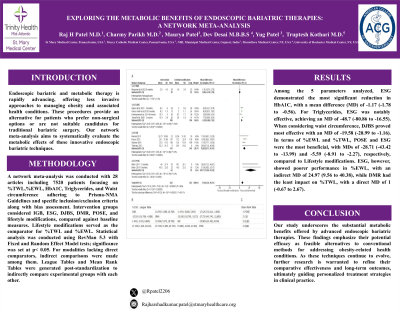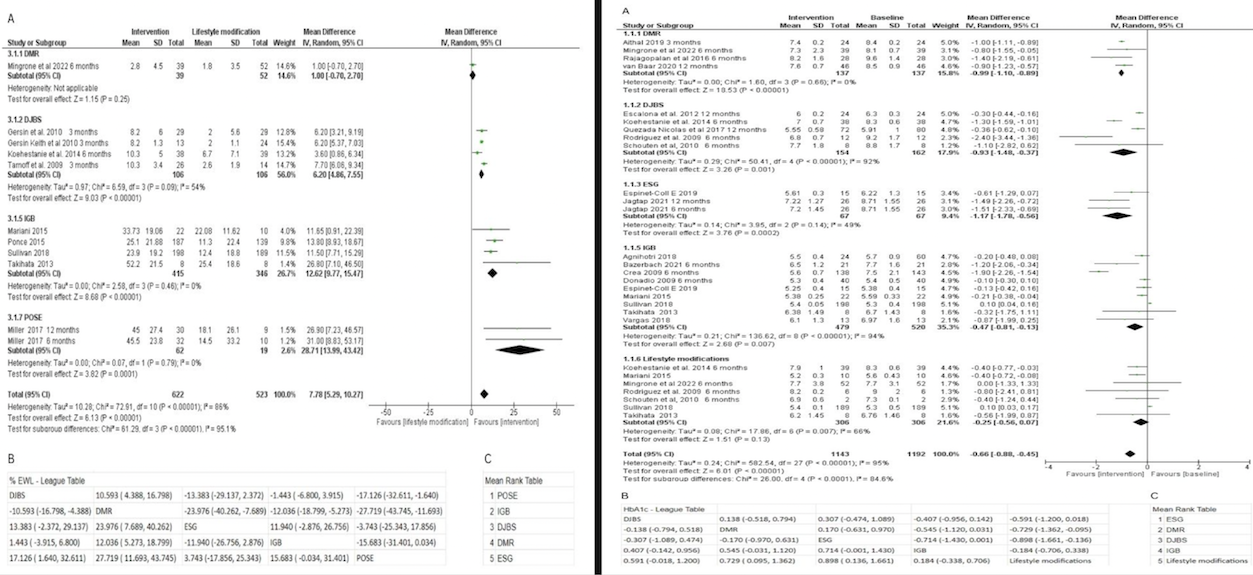Tuesday Poster Session
Category: Obesity
P4877 - Exploring the Metabolic Benefits of Endoscopic Bariatric Therapies: A Network Meta-Analysis
Tuesday, October 29, 2024
10:30 AM - 4:00 PM ET
Location: Exhibit Hall E

Has Audio
.jpg)
Raj H. Patel, MD
St. Mary Medical Center
Bensalem, PA
Presenting Author(s)
Raj H. Patel, MD1, Charmy Parikh, MD2, Maurya Patel, MBBS3, Dev Desai, MBBS4, Yug Patel, MBBS5, Truptesh Kothari, MD6
1St. Mary Medical Center, Bensalem, PA; 2Mercy Catholic Medical Center, Darby, PA; 3Smt. NHL Municipal Medical College, Ahmedabad, Gujarat, India; 4Montefiore Medical Center, Albert Einstein College of Medicine, Bronx, NY; 5Smt. NHL Municipal Medical College, Ahmedabad, Gujarat, India; 6University of Rochester Medical Center, Rochester, NY
Introduction: Endoscopic bariatric and metabolic therapy is rapidly advancing, offering less invasive approaches to managing obesity and associated health conditions. These procedures provide an alternative for patients who prefer non-surgical options or are not suitable candidates for traditional bariatric surgery. Our network meta-analysis aims to systematically evaluate the metabolic effects of these innovative endoscopic bariatric techniques.
Methods: A network meta-analysis was conducted with 28 articles including 7520 patients focusing on %TWL,%EWL, HbA1C, Triglycerides, and Waist circumference adhering to Prisma-NMA Guidelines and specific inclusion/exclusion criteria along with bias assessment. Intervention groups considered IGB, ESG, DJBS, DMR, POSE, and lifestyle modifications, compared against baseline measures. Lifestyle modifications served as the comparator for %TWL and %EWL. Statistical analysis was conducted using RevMan 5.3 with Fixed and Random Effect Model tests; significance was set at p< 0.05. For modalities lacking direct comparators, indirect comparisons were made among them. League Tables and Mean Rank Tables were generated post-standardization to indirectly compare experimental groups with each other.
Results: Among the 5 parameters analyzed, ESG demonstrated the most significant reduction in HbA1C, with a mean difference (MD) of -1.17 (-1.78 to -0.56). For Triglycerides, ESG was notably effective, achieving an MD of -48.7 (-80.86 to -16.55). When considering waist circumference, DJBS proved most effective with an MD of -19.58 (-28.99 to -1.16). In terms of %EWL and %TWL, POSE and ESG were the most beneficial, with MDs of -28.71 (-43.42 to -13.99) and -5.59 (-8.91 to -2.27), respectively, compared to Lifestyle modifications. ESG, however, showed poorer performance in %EWL, with an indirect MD of 24.97 (9.56 to 40.38), while DMR had the least impact on %TWL, with a direct MD of 1 (-0.67 to 2.67).
Discussion: Our study underscores the substantial metabolic benefits offered by advanced endoscopic bariatric therapies. These findings emphasize their potential efficacy as feasible alternatives to conventional methods for addressing obesity-related health conditions. As these techniques continue to evolve, further research is warranted to refine their comparative effectiveness and long-term outcomes, ultimately guiding personalized treatment strategies in clinical practice.

Disclosures:
Raj H. Patel, MD1, Charmy Parikh, MD2, Maurya Patel, MBBS3, Dev Desai, MBBS4, Yug Patel, MBBS5, Truptesh Kothari, MD6. P4877 - Exploring the Metabolic Benefits of Endoscopic Bariatric Therapies: A Network Meta-Analysis, ACG 2024 Annual Scientific Meeting Abstracts. Philadelphia, PA: American College of Gastroenterology.
1St. Mary Medical Center, Bensalem, PA; 2Mercy Catholic Medical Center, Darby, PA; 3Smt. NHL Municipal Medical College, Ahmedabad, Gujarat, India; 4Montefiore Medical Center, Albert Einstein College of Medicine, Bronx, NY; 5Smt. NHL Municipal Medical College, Ahmedabad, Gujarat, India; 6University of Rochester Medical Center, Rochester, NY
Introduction: Endoscopic bariatric and metabolic therapy is rapidly advancing, offering less invasive approaches to managing obesity and associated health conditions. These procedures provide an alternative for patients who prefer non-surgical options or are not suitable candidates for traditional bariatric surgery. Our network meta-analysis aims to systematically evaluate the metabolic effects of these innovative endoscopic bariatric techniques.
Methods: A network meta-analysis was conducted with 28 articles including 7520 patients focusing on %TWL,%EWL, HbA1C, Triglycerides, and Waist circumference adhering to Prisma-NMA Guidelines and specific inclusion/exclusion criteria along with bias assessment. Intervention groups considered IGB, ESG, DJBS, DMR, POSE, and lifestyle modifications, compared against baseline measures. Lifestyle modifications served as the comparator for %TWL and %EWL. Statistical analysis was conducted using RevMan 5.3 with Fixed and Random Effect Model tests; significance was set at p< 0.05. For modalities lacking direct comparators, indirect comparisons were made among them. League Tables and Mean Rank Tables were generated post-standardization to indirectly compare experimental groups with each other.
Results: Among the 5 parameters analyzed, ESG demonstrated the most significant reduction in HbA1C, with a mean difference (MD) of -1.17 (-1.78 to -0.56). For Triglycerides, ESG was notably effective, achieving an MD of -48.7 (-80.86 to -16.55). When considering waist circumference, DJBS proved most effective with an MD of -19.58 (-28.99 to -1.16). In terms of %EWL and %TWL, POSE and ESG were the most beneficial, with MDs of -28.71 (-43.42 to -13.99) and -5.59 (-8.91 to -2.27), respectively, compared to Lifestyle modifications. ESG, however, showed poorer performance in %EWL, with an indirect MD of 24.97 (9.56 to 40.38), while DMR had the least impact on %TWL, with a direct MD of 1 (-0.67 to 2.67).
Discussion: Our study underscores the substantial metabolic benefits offered by advanced endoscopic bariatric therapies. These findings emphasize their potential efficacy as feasible alternatives to conventional methods for addressing obesity-related health conditions. As these techniques continue to evolve, further research is warranted to refine their comparative effectiveness and long-term outcomes, ultimately guiding personalized treatment strategies in clinical practice.

Figure: (A) Forest plot showing the change in % EWL and HbA1c after different treatment modalities. (B) League Table comparing the effectiveness of various interventions on % EWL and HbA1c, presented as mean differences with 95% confidence intervals, (C) Mean Rank Table summarizing the relative effectiveness of each intervention on %EWL and
Disclosures:
Raj Patel indicated no relevant financial relationships.
Charmy Parikh indicated no relevant financial relationships.
Maurya Patel indicated no relevant financial relationships.
Dev Desai indicated no relevant financial relationships.
Yug Patel indicated no relevant financial relationships.
Truptesh Kothari indicated no relevant financial relationships.
Raj H. Patel, MD1, Charmy Parikh, MD2, Maurya Patel, MBBS3, Dev Desai, MBBS4, Yug Patel, MBBS5, Truptesh Kothari, MD6. P4877 - Exploring the Metabolic Benefits of Endoscopic Bariatric Therapies: A Network Meta-Analysis, ACG 2024 Annual Scientific Meeting Abstracts. Philadelphia, PA: American College of Gastroenterology.
